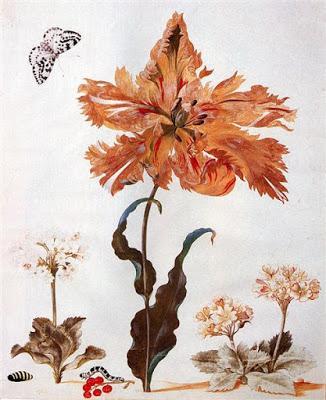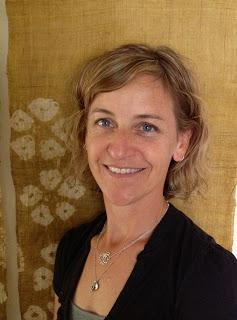
A Parrot Tulip, Auriculas, And Red Currants,
With A Magpie Moth, Its Caterpillar And Pupa
by Maria Sibylla Merian
As a twenty-something, I did not recognize grief as something to be experienced but rather as something to escape. However, losing my grandmother was the first of many stars to line up for my path to becoming a hospice nurse. I watched the nurses who cared for her in her last days with tenderness and selflessness, and the seed was planted that one day I wanted to do just that. I wasn’t ready at the time, but as I matured into my thirties, I decided to be of service and enrolled in nursing school. My career began in the field of oncology, helping those with cancer to battle their disease. When I witnessed the lightness of letting go that came with choosing “comfort measures only,” I knew that my path was leading to hospice work.And losing my long-term love relationship was the first star to line up for my path to becoming a yoga teacher. I can vividly remember taking a yoga class while I was grieving the loss of my love and our around-the-world adventure. Neither of us died, but our relationship and adventure did. I had been so attached to the idea of sailing around the world that I overlooked all the troubles we were battling as a couple. After all was done between us, I spent the better portion of an evening yoga class in Child’s pose, tears dropping to the mat beneath my nose. My kind instructor that night taught class kneeling by my side, softly rubbing my back as she called out instructions to the rest of the class. She was offering herself in service to the class, and a light came on that perhaps one day I would want to serve as a yoga teacher as well. That same teacher who so graciously knelt beside me would ask me to start teaching with her the following year. I apprenticed with her and my love of teaching yoga was ignited. My experience in class after losing my long-term love wasn’t the last time I would turn to a roomful of yogis to support my feelings of loss. In 2014, I lost a dear friend tragically in an avalanche. The community lost an amazing spirit, and her family lost a wife and mother. We were on such similar life paths, and I was overcome with depression and grief. I was unable to get out of bed for days and unable to care for myself or my own family. Slowly, the darkness of this event began to lift and I was able to get myself to yoga. Another kind and understanding teacher held space for me that day, when again I wept through the end of class. She stayed near me as I rested in Supta Baddhakonasana, my heart open to the skies and tears streaming down my cheeks. She placed a singing bowl upon my belly and chanted gently to the class, but also right to me. I was held. As teachers or students, we are drawn to yoga for so much more than the physical practice. Yoga offers community, love, emotional support, and spiritual grounding. We turn to yoga not to escape our lives, but to more fully experience them.Concurrent to my own grief experiences, as a hospice nurse, I have had the fortune to be present for hundreds of families for the past five years as they experience grief. I have learned that grief has no identity. You can’t tell someone what their experience will look like or feel like or how long it will take. At the end of life, some families are able to accept the loss of a loved one, and some fight it. The same is true about how families grieve. As a nurse, I allow their experience to unfold and gently encourage them to stay present with the dying person, to not have expectations about what is unfolding. To just be present, in the place and in the moment, where they are witnessing a natural cycle of life. I have also learned in holding space that some folks need to do something—anything—to get their mind off of their loss. Other folks need to pause and experience the raw emotion and allow it to wash out of them completely so that they can move forward in life. I recently read a beautiful quote by Jamie Anderson stating that “grief is just love with nowhere to go.” So whether someone wants to curl up and sit with that love or they want to work at letting it go, as a nurse and a yoga teacher, I am honored to be able to hold space for whatever comes.In my yoga classes, I have a large number of students over the age of 65. So often my students are experiencing the loss of a significant other or parent or of their own health status. We have a community in our class, and it brings warmth to my heart to watch fellow students inquire how someone is doing, to watch them wrap each other in a hug, and to see the support that they offer just by being present in the room.I cherish the opportunity to start a class with meditation. It allows students to sit with their difficult emotions, to let their tears flow, and to accept the reality of our true human nature. We are all in this together. When I know a student is experiencing loss, or when I am experiencing my own grief, I like to include some of the following in our practice:Supported Balasana (Child’s Pose). Balasana allows us to curl up and feel physically and emotionally internal. It allows the opportunity to hide from the external cause of our grief.Supported Supta Badakonasana (Reclined Bound Angle Pose). From our hiding place in Child’s pose, we can open up physically and yet feel the support of props to keep us grounded. The props I like to use include: a blanket or bolster under the spine, blocks under the knees, a strap around the back and feet, an eye pillow, and even a sandbag across the front of the hips. In this heart-opening pose, the love that is trapped inside us as grief can be energetically sent out to the universe. We can experience the love as love when we send it outward.Kashtha Takshanasana (Wood Chopper Breath). This Kundalini kriya is similar to a Lion’s Breath in that it physically forces out pent-up energy. From the reclined poses, I encourage students to pick themselves up and come to either Malasana (Garland pose) or to standing with the feet wide. Taking a moment to notice where we still feel pent-up grief, we deeply inhale as we raise arms overhead and bring the hands together, and then quickly exhale forward with a chopping motion of the arms while letting out a “HA!”. We repeat 5-7 times and then rest standing upright.Ultimately, I believe that any yoga practice is a good yoga practice for grief. I often advise students or families of the dying that just taking three long slow breaths can turn a moment of deep sadness into a moment of transition. In the pause of just recognizing what you are feeling, you immediately transform from being overtaken by an emotion to experiencing a moment. In that pause, you recognize the temporary nature of your grief. In that pause, you see the light in your dark situation and see that time will help.

Subscribe to Yoga for Healthy Aging by Email ° Follow Yoga for Healthy Aging on Facebook ° Join this site with Google Friend Connect

